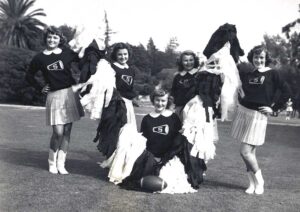
Santa Monica High School graduate Elaine (Jones) Stephenson (Class of 1951) has almost finished writing "All the Painted Ponies", a charming non-fiction book about growing up in Santa Monica in the ‘40s.
Told through the eyes of 11-year-old "Laney," the book has been on Elaine's "To Do Today" list for decades. She hopes to send it to a publisher in April. (Won't that be satisfying to finally run a line through it?)
In a chapter entitled, "California Dreaming," Laney describes the grueling five-day 1944 Greyhound Bus trip from Rhode Island to Santa Monica. Her mother and four siblings were reuniting with Elaine's father waiting for them in Los Angeles.
An artist, Eric Jones had gotten a job at the Hippodrome on the Santa Monica Pier which housed the famed carousel. Among Eric's duties was painting the hand-crafted wooden horses on the merry-go-round and all the scenes and decorations on the walls.
In the wartime era, jobs and especially housing were in short supply. So it was that Elaine and her family lived in a three-room apartment above the merry-go-round from 1944 to 1951. (There were seven apartments above the carousel but in 1974 an arson fire to the building forced evacuation and closure.)
Laney describes her breathtaking first view of the merry-go-round.
"Some of the horses with their brightly colored saddles, were solid white with flecks of gold and silver shining in their manes; others were glossy black stallions, mottled grays, chestnuts, palominos and spotted black and white ponies. And in the middle of each saddle was a gleaming brass pole. Glowing electric lights and shiny mirrors circled the wooden animals like a gigantic jeweled crown."
For Laney and her siblings growing up at the beach made for a childhood filled with adventures. But the apartment was tiny and the music from the carousel's Wurlitzer could be tedious to say the least. Then again, it was a good excuse for the kids to play outside on the sand or on the pier or at Muscle Beach.
While it was paradise for the kids it presented many challenges for Elaine's mother. (Both of Elaine's parents were British-born.) But, ever resourceful, she made it work with the help of new furniture.
As Laney recounts, "Bunk beds filled the bedroom with the fresh smell of new wood. Mom had ordered bedspreads from the Sears and Roebucks catalog. They were made of white chenille and embroidered with navy blue sailboats and red sea shells. We were beginning to feel at home. Home, sweet, merry-go-round home."
Another problem was getting to the clothesline on the roof of the Hippodrome required climbing two flights of stairs and going through a neighbor's apartment. Mrs. Carlton enjoyed the company but Elaine's mother didn't like imposing. But Laney's father came up with a solution.
"My dad cut a nice square hole in the alcove ceiling, finished the edges and made a neat and tight cover for it. Then he bought a ladder that went up to the ceiling to reach the opening. It made wash day a whole lot easier for mom."
But pre-teen Laney, who had lived on the East Coast and felt different enough, wanted more than anything just to fit in with the "California kids" at Madison Elementary. So, as many children have secrets growing up, living above the merry-go-round was Laney's. And perhaps not completely unfounded.
With its four turrets on the corners and its huge cone-shaped dome on the roof, the Hippodrome presented a castle-like appearance. But, built in 1916, by the ‘40s it was shabby and rundown. As kids in school are prone to do, Laney feared she would be made fun of by her classmates.
But, for the most part, Laney flourished. In fact, as a teenager, she occasionally modeled and once was featured on the front page of the "Evening Outlook," Santa Monica's newspaper. (Long before the Daily Press.) At Samohi she enjoyed being a member of the prestigious Song Leader squad.
Over the course of the book Laney goes from a young girl to a young woman. In 20 chapters, enhanced by a dozen vintage photos, "All the Painted Ponies" is a poignant and nostalgic look back on small town Santa Monica that I barely recognize but would have loved to live in. And so endearing are the stories, by the book's end, the reader almost feels a part of the Jones' family.
Hopefully "Painted Ponies" will be published soon and I can officially review it. And of course, then Elaine can officially cross it off her "To Do" list.
Jack can be reached at facebook.com/jackneworth, twitter.com/jackneworth or via e-mail at jnsmdp@aol.com.








